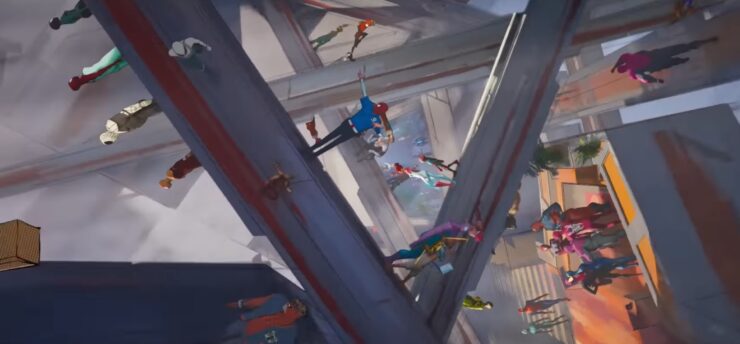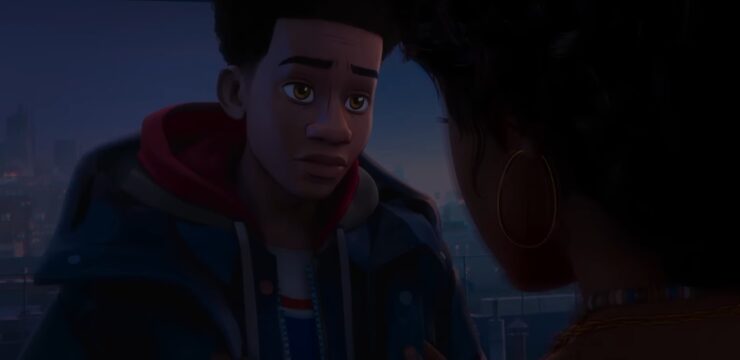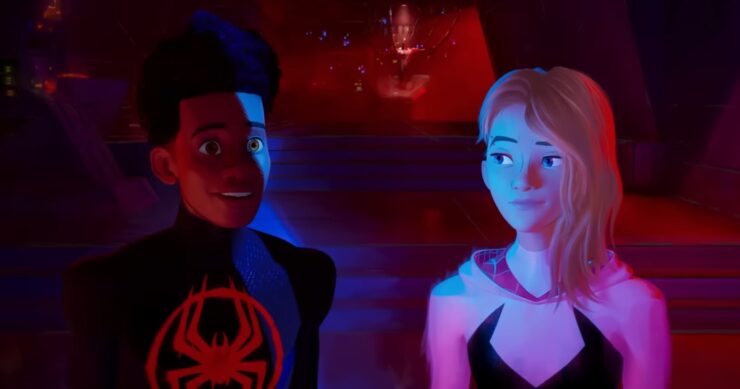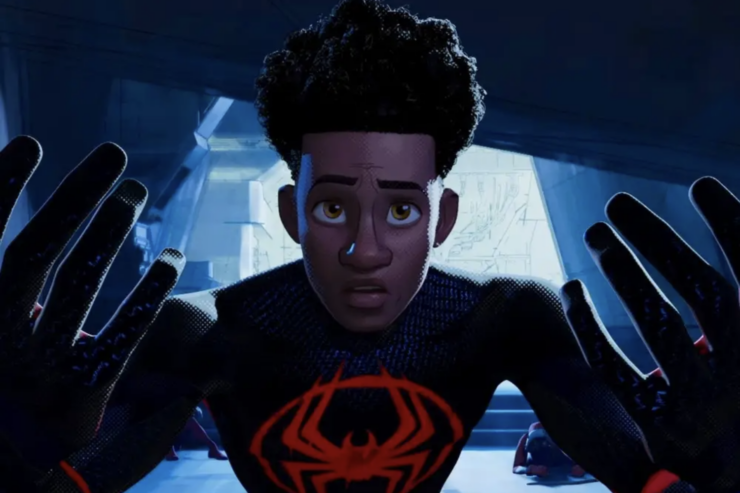There are over 250 Spider-People in Spider-Man: Across the Spider-Verse, up from just seven in Spider-Man: Into the Spider-Verse. Surely it wouldn’t be possible to give our protagonist, Miles Morales, our meaty storyline. And then, when the film started off with an extended sequence featuring Gwen Stacy, I was convinced that Miles was going to be a passenger in his own sequel. With a glut of Spider-People, new villains and multiple universes to introduce, how would the writing-directing team behind Spider-Man: Across the Spider-Verse focus on Miles and make the film his story?
In the opening sequence of the film, set on Earth-65, Gwen introduces us to the central conceit of the film—Miles Morales is not the only one to be bitten by a radioactive spider, to lose a loved one, to feel like he’s going it alone as a Spider-Person. Miles Morales is not unique. But, as Gwen eventually finds out, he is. Not only diegetically because he’s an anomalous Spider-Man who refuses to follow the rules, but Miles is also unique in being a biracial Spider-Man who headlines his own comics and now this film series.
Spider-Man: Across the Spider-Verse takes a meta approach to telling Miles’ story—according to the film’s antagonist Miguel O’Hara/Spider-Man 2099, there are fixed points in a Spider-Person’s life that must occur if they are to become a superhero, such as the death of an uncle and a police captain close to them. These are canon events and going against canon will literally end worlds, and even the web of life itself. We witness the aftermath of a disrupted canon event when Miles saves Police Inspector Singh’s life on Earth-50101, which opens up a spatial tear. How many discourses have we witnessed or participated in about canon events in pop culture? Battles have been fought and lost over and over again as people venerate the arcs and characters from comic books that they liked while decrying the assassination of their childhoods when something or someone slightly different comes along.
Miles, as a character, has been at the centre of many a fandom argument since he first appeared within comic pages in 2011, and continues now with his jump to the big screen. Vocal groups of the Spider-Man fandom refuse to accept or respect him. They hang on to Peter Parker like webfluid. And that’s what makes the film so powerful; Miles isn’t real but he represents the resiliency needed by marginalized groups of people to get back up and take control of their narrative even against insurmountable odds.

Throughout the film, Miles, and the audience, is told what his story should be. His school principal, Ms. Weber, decides that the only way he can get into Princeton to study quantum physics is by telling his story—except it’s not his story at all. Miles is expected to write that he’s from a struggling immigrant family, even though Miles and his parents, Rio and Jeff are Americans, with good jobs and a comfortable lifestyle. It’s not ‘til Miles speaks up about his passion to dive into cutting-edge science that could possibly break the barriers between dimensions (so that he can travel to other Earths and be with Gwen and his other Spider-Friends, but no one needs to know that), that Weber sees Miles for who he is. This is the first inkling that Miles will be fighting to tell his own story for the nearly three-hour runtime.
Later, on Nueva York, Earth-928, Miles meets Miguel O’Hara and the Spider Society. He’s so excited to meet his people, but they’ve already decided his story for him, and that he’s not one of them. Miles wasn’t inducted into part of the Spider Society since he was never meant to be a Spider-Man. Earth-1610, which Miles is from, was still supposed to have a Peter Parker, but instead, Miles was accidentally bitten by Earth-42’s radioactive spider, and Peter died protecting Miles. Earth-1610’s canon changed and Earth-42 was sans a Spider-Man. Miles is the original anomaly, as Miguel puts it. He’s the reason the space-time continuum has been affected, and he’s the reason the dimension-hopping villain Spot is on the loose.
Miles, in the face of an entire society of his peers, takes the narrative by its spindles and says: “Everyone keeps telling me how my story is supposed to go. Nah. I’m-a do my own thing.”
People keep telling Miles who he should be, what he should do, and why. But aside from his parents, no one centres Miles in the story. Miles has been up against it his whole life; we don’t have to see it on screen to know it. We can understand that Miles’ family wouldn’t have been able to afford tuition at the exclusive Visions Academy—Miles had to work extremely hard to pass the entry test and earn a spot through the school lottery, and continues to work equally hard to survive at this school. The Moraleses are not a rich family, but they are rich in love, which is why Miles perseveres.
In the first film, when he first got his powers, he had to prove himself over and over again to make sure he got to be the hero in his own story. And in the sequel, he has to do so again, but this time to prove himself to an entire Spider Society. Miles is more than accomplished enough to be part of the Society—he has Spider-skills, the venom blast, venom strike and he can turn invisible. The other Spiders don’t have that. Plus, he has empathy in spades. The only reason he isn’t accepted is because he’s different. And this is exactly what his mother was afraid of.

Rio Morales may not be ready to accept that her ‘little boy’ is growing up, but she can see that the young man in front of her is struggling to reveal his secrets. She is protective because she knows that the world may not be as accepting, loving, or respectful of Miles. The underlying message is, the world is racist and prejudiced, and he’s part of two communities that bear the brunt of those prejudices. Diegetically, the writers avoid Miles facing a constant stream of racist attacks, but it’s there like in his interaction with Ms. Weber. So it’s all that much worse when the Spider Society discriminates against him as well because he’s not like everyone else. It’s not the colour of his skin that matters to Miguel and the Spider Society, it’s the fact that he wants to do things his own way. Miles wants to break canon and he wants to stop the notion that suffering and sacrifices are the only ways to be a Spider-Person.
Miles ends up fighting the entire Spider Society, and it’s all because he refuses to accept his destiny—that being a Spider-Person is a sacrifice, not a gift. Miles already lost his Uncle Aaron; so many Spider-People lost their Uncle Bens, among others, and now Miles just has to accept the loss of his father too? No way.
It’s no wonder Miles is so chuffed after he escapes Nueva York and thinks he’s returned home. He’s full of pride as he tells his mother—or the person he thinks is his mother—about how he’s strong and he beat everyone who doubted him. He thinks he’s made it.
Buy the Book


System Collapse
What Miles does at this point in the film is take back the opportunity to make a choice. Any choice. Miles had been afraid of his parents’ reaction to him hiding his secret identity as Spider-Man for over a year, and his fears were seemingly proven right when Gwen warned Miles against making this revelation, because her own father, Captain George Stacy, had reacted poorly to the information. But, George eventually accepted her and her secret; granted he almost shot her and she had to run away before he did, but father and daughter reconciled by the end of the film. Miles knows none of this, but he chooses, of his own volition, to tell his mom his true identity (unfortunately, it’s her doppelganger, so he’ll have to choose to come out again). Miles also chooses to admit that Spot is his nemesis; up until that point, Spot was the one who kept calling himself that. This was the moment that Miles grew up and owned his own mistakes—he hadn’t taken Spot seriously and Spot became much too powerful while Miles was looking elsewhere. By naming Spot his nemesis, he’s finally acknowledging that treating the villain as the actual threat that he was would have solved a lot of his, and the multiverse’s problems.
The film, therefore, earns its cliffhanger. The big reveal that Earth-42’s Miles G. Morales is the criminal the Prowler wouldn’t have been as shocking without telling Miles’s story of growth and strength. Earth-42 doesn’t have a Spider-Man, and on this Earth, Jeff Morales was the one who died, not his brother. Earth-42 Miles is under the influence of his Uncle Aaron—the man Miles used to idolize before he found out that his uncle was a villain. The kind, empathetic hero that we know and love would have turned out to be stone-cold bad guy. The cliffhanger leaves us wondering whether this could have been Miles’ story if he wasn’t Spider-Man. Is this the path that Miguel, unwittingly, wished for? If only he was on Earth-42 to witness it and see how wrong he was to demand Miles’ story was different.
By ending the film with Miles facing his alternate self, Spider-Man: Across the Spider-Verse shows audiences who Miles could have turned into if he didn’t have the loving, nurturing family that he does, if he didn’t have the father he would break canon to save. Maybe being a Spider-Person is a sacrifice, but the alternative that Miles avoided looks so much worse.
Spider-Man: Across the Spider-Verse allows Miles to reclaim his story by centering his coming-of-age arc. Miles is shaping his own future while balancing his life as a teenager and a superhero. It’s not easy, and we see him make mistakes along the way. But there are choices, and he’s the one making them. Every step of the way, Miles is the origin of the plot—the Spider Society wouldn’t have existed had Miles not become an accidental Spider-Man. Miles is the original anomaly in the Spider-Verse. The main threat of the film is Spot, who becomes Miles’ nemesis because Miles threw a bagel at him in the first film and destroyed the collider, where Spot used to work.

The creators of Spider-Man: Across the Spider-Verse played upon our fears of their lead character of colour disappearing from the story, and turned that fear into the central plotline. Miles is desperate to belong in the Spider Society, and the spectacle of hundreds of Spider-People feeds into that desire. Miles has been the one and only Spider-Man of his world for a year— wanting to belong to something and be with people like him is understandable. He could easily have been lost in the crowd, the sole Miles Morales in a sea of Peter Parkers (with some exceptions). We live in a world where people of colour are still expected to diminish themselves to fit in, to toe the company line and maintain the status quo. To watch Miles defiantly refuse to follow the herd, even if that meant not being welcome among people he so desperately wanted to be with, is a statement in itself.
Miles’ actions set him apart from the rest of the Spider-people—aside from Hobie Brown, all the others blindly follow Miguel’s orders to be slaves to the canon, even though it means accepting sacrifice and grief. Miles doesn’t acquiesce, doesn’t back down, and doesn’t give up, which allows him to take control of the narrative and make it his own. He may have painted a target on his back, but Miles is more than capable of turning that target into a spotlight.
Monita Mohan champions diversity, inclusivity, and representation through her writing at Collider.com, Women Write About Comics, HuffPost, Bam Smack Pow, and Show Snob.










